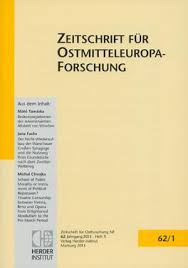Kosaken zwischen Tatendrang und Rechtfertigungsdruck. Ordnungsvorstellungen einer Gewaltgemeinschaft im Kontext von Konkurrenz und Gewaltkultur
Cossacks between the Urge to Take Action and the Need to Justify Themselves. Concepts of Order in an Organised “Community of Violence” in the Context of Competition and a Culture of Violence
Author(s): Daria StarčenkoSubject(s): Victimology, 17th Century, Eastern Orthodoxy
Published by: Verlag Herder-Institut
Keywords: Cossacks; Organised “Community of Violence”; Competition; Culture of Violence;
Summary/Abstract: Even if we are still awaiting a ‘violent turn’ in the historical studies, it has already become impossible to keep track of the plethora of publications on the subject of violence. Nevertheless, the phenomenon of collective violence has remained largely unexamined, in spite of the fact that violence is predominantly a social phenomenon. According to Heinrich Popitz, the power to kill (latent and manifest) is a determinant of all forms of societal living. As Popitz somewhat provocatively puts it, there is no all-embracing social order which is based on the premise of non-violence. In this paper I examine the loosely constructed concepts of order in the organised “Community of Violence” which was the social group of Polish-Lithuanian Cossacks, in the context of their (violent) actions, and I explore the example of the Cossack rebellion of 1637/38, which was marked by a struggle for superiority between the various groups of Cossacks. In consequence, the pivotal question which arises is that on the significance of violence and competition in the social cohesion and power structures of the Cossacks. The starting point is the observation that the social phenomena of physical violence are conveyed to the outside world both by the actions and by the ideas of the perpetrators of violence. This article traces the strategies used to justify and legitimise the violence carried out by its perpetrators, and elaborates upon the values and conceptions which they manifest. Thus it will become apparent that this organised “Community of Violence” constructed ready-made interpretations of their own (violent) actions in order, for their own ends, to impose limits on the range of possible attributions, and to position themselves as positive participants in violent events. From the perspective of the organised “Community of Violence” of the Polish-Lithuanian Cossacks, violence was highly regarded a means of securing civil order.
Journal: Zeitschrift für Ostmitteleuropa-Forschung
- Issue Year: 60/2011
- Issue No: 4
- Page Range: 494-518
- Page Count: 25
- Language: German

